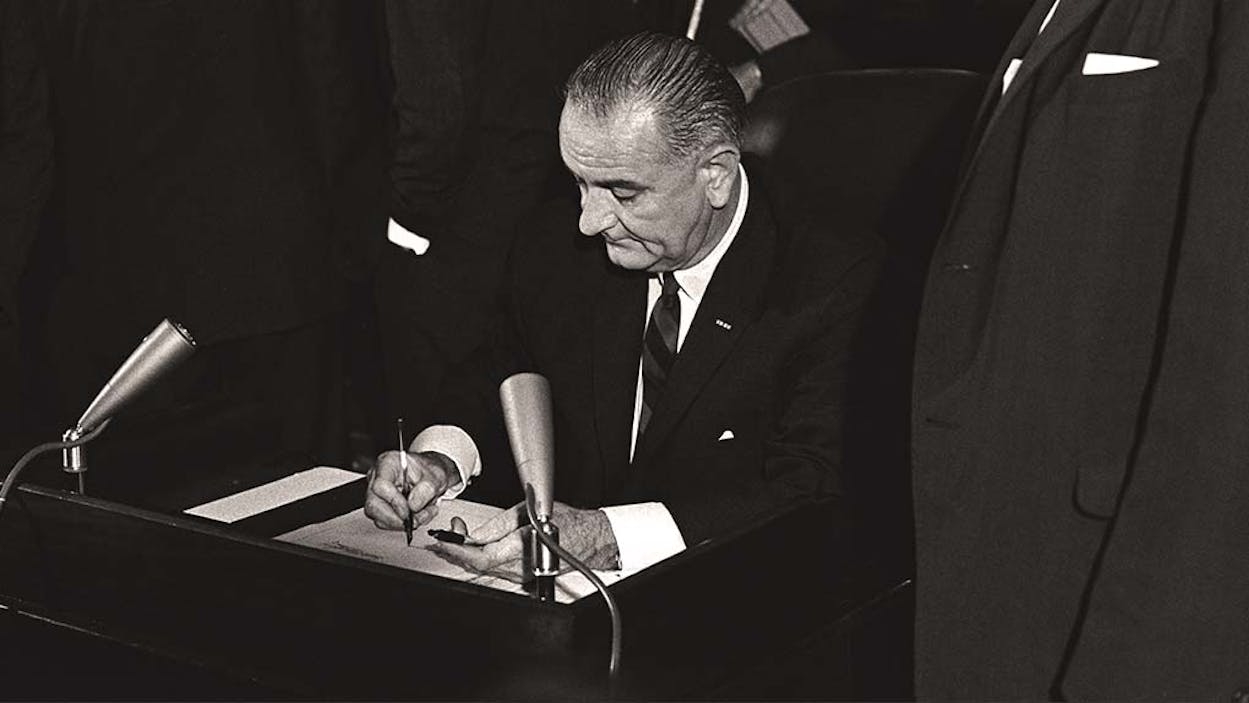During these days of presidential jockeying—when we find ourselves bracing for a long-lasting spectacle of debates and speeches and politicians trying to prove their Spanish-language bona fides—it’s hard to remember a time when candidates did not have to aggressively court a diversity of voters to be elected to office. But as the second term of our first black president draws to a close, it is clear that our current political landscape, unimaginable even a few decades ago, owes its existence to a single, transformative act of federal legislation.
Fifty years ago, President Lyndon B. Johnson signed the Voting Rights Act into law, giving African Americans what they had never had before: political power. “The vote is the most powerful instrument ever devised by man for breaking down injustice,” he declared before members of Congress on August 6, 1965, shortly before signing the bill. The statute forever changed the ground rules of American politics; it forbade so-called literacy tests, which white officials in the Deep South had used for decades to bar blacks from casting ballots, and it put the voting practices of seven Southern states under strict federal oversight. The act’s passage was “a triumph for freedom as huge as any victory that has ever been won on any battlefield,” Johnson said that August day in a speech that was televised to a national audience. “Every family across this great, entire, searching land will live stronger in liberty, will live more splendid in expectation, and will be prouder to be American.”
Though LBJ’s views on civil rights were indisputably shaped by his experiences as a schoolteacher in South Texas, the Voting Rights Act would not apply to his home state until a full decade after its passage. It would take another Texan, in fact, to expand the law. Barbara Jordan, as the first black congresswoman from the South, was keenly aware of the challenges faced by minority voters; she had observed the difficulties that many of her Spanish-speaking constituents in Houston faced at the polls. The English-only ballots then in use were no different from literacy tests, she argued, telling her colleagues in the U.S. House of Representatives that states should be required to provide bilingual ballots and registration forms. Citing examples of voter intimidation, she also argued that federal oversight of voting practices should be expanded to areas with large numbers of Spanish-speaking voters, including Texas. On August 6, 1975—the act’s tenth anniversary—President Gerald Ford signed this broadened version into law in the Rose Garden, with Jordan watching over his shoulder.
Yet half a century after this landmark legislation, Texas is not remembered as the state whose political icons blazed a trail for voting rights but as a state whose lawmakers have actively disenfranchised minority voters by using creative ways to delineate the state’s congressional districts and by instituting unnecessarily burdensome voting requirements.
This about-face was made possible by a 2013 U.S. Supreme Court ruling, Shelby v. Holder, which eviscerated the Voting Rights Act after finding that a key provision of the law was based on decades-old data about voter discrimination and was, as a result, unconstitutional. (It ignored Texas’s long history of voting irregularities and the fact that the state has lost more Section 5 lawsuits—legal battles over whether a change to election procedures had a discriminatory purpose—than any other state.) The court’s decision effectively ended the requirement that nine states, including Texas, seek “preclearance” from the federal government before altering their election laws. After Shelby, the Legislature was free to modify the rules and redraw congressional district maps without Justice Department approval.
Two years later, Texas elections look very different. The state now has one of the strictest voter ID laws in the nation, requiring people to bring government-issued photo identification to the polls—even though low-income Texans, who are disproportionately black and Hispanic, are at least eight times less likely to have the necessary kind of ID. (Someone who lives below the poverty line is less likely to have access to a vehicle and, therefore, a driver’s license.) The Legislature also made the regulations that govern voter registration drives particularly onerous, even though blacks and Hispanics are nearly twice as likely as whites to register to vote through such drives. And lawmakers have so aggressively gerrymandered the state that the number of congressional seats to which minority voters can elect a candidate has declined even as the population growth of blacks and Hispanics around the state has far outpaced that of whites. Minority voting rights may soon be further restricted by Evenwel v. Abbott, a Texas case that the Supreme Court will hear in its next term, which concerns whether congressional lines should be drawn according to total population or the number of eligible voters.
Yet even before recent attempts to undermine the Voting Rights Act, Texas enjoyed the dubious distinction of often having the most abysmal voter turnout in the country. In the past two presidential elections, Texas came in forty-eighth among all fifty states in voter participation. And in the 2014 midterm election—despite the most spirited governor’s race in recent memory and a massive voter outreach effort by the left-leaning organization Battleground Texas—the state came in dead last. Just 25 percent of Texans who were old enough to vote cast ballots. Hispanics, who have historically turned out with far less frequency than their white and African American counterparts, made up just 17 percent of the vote in Texas, despite accounting for 38 percent of the population.
What would LBJ and Jordan have made of all this? What do these statistics mean for a state that’s already majority-minority but where whites continue to hold nearly every statewide office? Half a century after the Voting Rights Act, we must consider both the road we’ve traveled and the one we’re headed down. The following pages aim to do just that, featuring a profile of Curtis Graves, who in 1967 became the first black man to serve in the state House since the nineteenth century and helped redefine African American politics in Texas; a personal look at the South Texas town of Cotulla, where LBJ’s experiences as a young teacher working with disenfranchised Hispanics informed his later civil rights record; and interviews with millennials in the Rio Grande Valley, an area that boasts some of the state’s lowest voter turnout. As we honor the fiftieth anniversary of civil rights touchstones with the likes of Selma and a slew of LBJ retrospectives, we cannot forget that having a vote, and the ability to exercise it, is as crucial to our future as it has been to our past.
- More About:
- Politics & Policy
- LBJ
- Barbara Jordan








